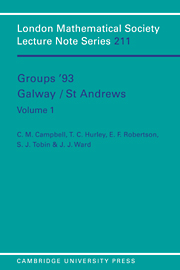Book contents
- Frontmatter
- Contents
- Preface
- Introduction
- Geometry, Steinberg representations and complexity
- The structure of metabelian finite groups
- Table algebras of extended Gagola-type and applications to finite group theory
- On the saturation of formations of finite groups
- Locally constructed formations of finite groups
- Reflections on virtually one-relator groups
- Rickard equivalences and block theory
- Computing the conjugacy classes of elements of a finite group
- Quotient categories of modules over group algebras
- Weak chain conditions for non-almost normal subgroups
- Computation of the character table of affine groups using Fischer matrices
- The lattice of compact representations of an infinite group
- Automorphisms of nilpotent and related groups
- Generation of orthogonal groups over finite fields
- The structure of certain Coxeter groups
- n-free groups and questions about universally free groups
- Classification of all generating pairs of two generator Fuchsian groups
- Parametric words and models of the elementary theory of non-abelian free groups
- The groups G(n, l) as fundamental groups of Seifert fibered homology spheres
- Lifting automorphisms: a survey
- (MI)-groups acting uniserially on a normal subgroup
- Revisiting a theorem of Higman
- Cohomological finiteness conditions
Reflections on virtually one-relator groups
Published online by Cambridge University Press: 02 March 2010
- Frontmatter
- Contents
- Preface
- Introduction
- Geometry, Steinberg representations and complexity
- The structure of metabelian finite groups
- Table algebras of extended Gagola-type and applications to finite group theory
- On the saturation of formations of finite groups
- Locally constructed formations of finite groups
- Reflections on virtually one-relator groups
- Rickard equivalences and block theory
- Computing the conjugacy classes of elements of a finite group
- Quotient categories of modules over group algebras
- Weak chain conditions for non-almost normal subgroups
- Computation of the character table of affine groups using Fischer matrices
- The lattice of compact representations of an infinite group
- Automorphisms of nilpotent and related groups
- Generation of orthogonal groups over finite fields
- The structure of certain Coxeter groups
- n-free groups and questions about universally free groups
- Classification of all generating pairs of two generator Fuchsian groups
- Parametric words and models of the elementary theory of non-abelian free groups
- The groups G(n, l) as fundamental groups of Seifert fibered homology spheres
- Lifting automorphisms: a survey
- (MI)-groups acting uniserially on a normal subgroup
- Revisiting a theorem of Higman
- Cohomological finiteness conditions
Summary
Introduction
Group theoretical investigation and classification efforts take advantage of the various group theoretical constructions: the attempt is to recapture information about groups of interest from their various subgroups, homomorphic images and extensions. The particularly successful theory of one-relator groups - which greatly benefitted from the pioneering work of W. Magnus - provided motivation for investigating one-relator quotients of free products as well as extensions and automorphisms of free groups. Questions of SQ-universality and recognizability, stemming from decision problems, also added interest in one-relator groups possessing free quotients, and in various groups with free subgroups.
Recall that if P is a group property, then a group G is virtuallyP if it has a subgroup of finite index satisfying P. Alternatively we also call G a virtual P-group. G is P-by-finite if G has a normal subgroup of finite index satisfying P. If P is a subgroup inherited property, such as torsion-freeness, freeness, or solvability then virtually P and P-by-finite are equivalent.
The structure of virtually-free groups {free-by-finite groups} is rather well understood {see Section 3} and generalizes the structure of free groups in expected ways. Virtually free groups also have connections with automatic groups and hyperbolic groups {see Section 3}.
The present paper represents the start of a general program to extend knowledge about virtually one-relator groups. The aim is to line up known results and give some extensions of relevance to the proposed project. Since a good number of properties of free groups appear in one-relator groups it is hoped that a similar parallelism can be detected for virtually one-relator groups.
- Type
- Chapter
- Information
- Groups '93 Galway/St Andrews , pp. 37 - 57Publisher: Cambridge University PressPrint publication year: 1995



